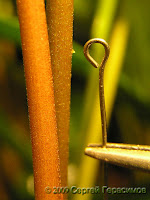
In my opinion Anubias gilletii is one of the most beautiful representatives of its genus. The laminae of this plant have a tribolate structure and are grown up horizontally to the surface on the long (up to  to
to
If we looked at Anubias gilletii with the eye of a taxonomist here is also everything quite, calm and beautiful. Perhaps it’s a  unique case among large Anubias species , which doesn’t give rise to doubt in a generic denomination. We can find only one species of this plant on the post-Soviet territory, this species I described above. Practically there is no information about this anubias in Internet. There are photos from the botanic garden in Lyons (
unique case among large Anubias species , which doesn’t give rise to doubt in a generic denomination. We can find only one species of this plant on the post-Soviet territory, this species I described above. Practically there is no information about this anubias in Internet. There are photos from the botanic garden in Lyons ( hotos which were made by
hotos which were made by
There are not so many negative qualities of Anubias gilletii. For example, the growth in a submersed condition isn’t so good . But we can see some cases, when this plant has been cultivated in aquarium during a year. Besides in spite of the fact, that Anubias gilletii has riotous and regular flowering at home greenhouse, it’s very difficult to achieve the aging of pollen. Due to the high air humidity (about 98%), which is arisen in small aquaria or paludaria; there is the fast rotting and decomposition of the male part cop’s tissue.
The author of this note: Dmitry Loginov.
The author used information from the next Web page
Translated from Russian by Julia Niklyaeva and Alexander Grigorov
Photos: Sergey Gerasimov, Dmitry Loginov and Valentina Romanova.
© Dmitry Loginov
© Alexander Grigorov



No comments:
Post a Comment